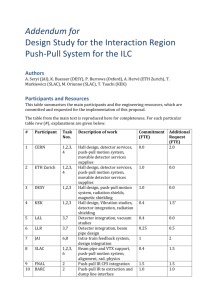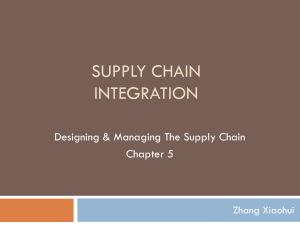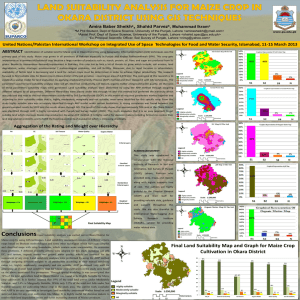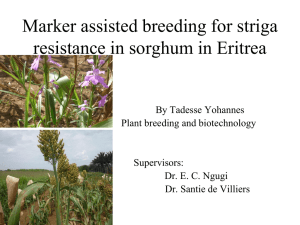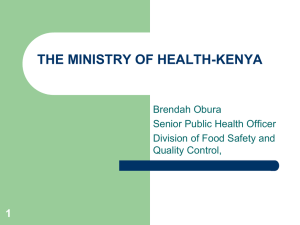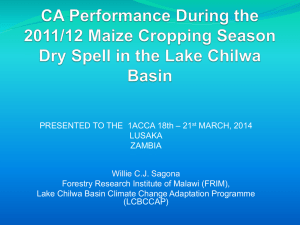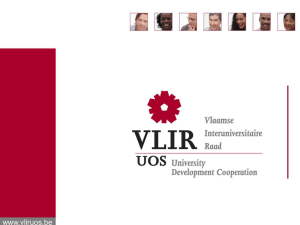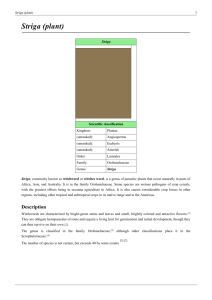Climate-smart push-pull - 1st Africa Congress on Conservation
advertisement
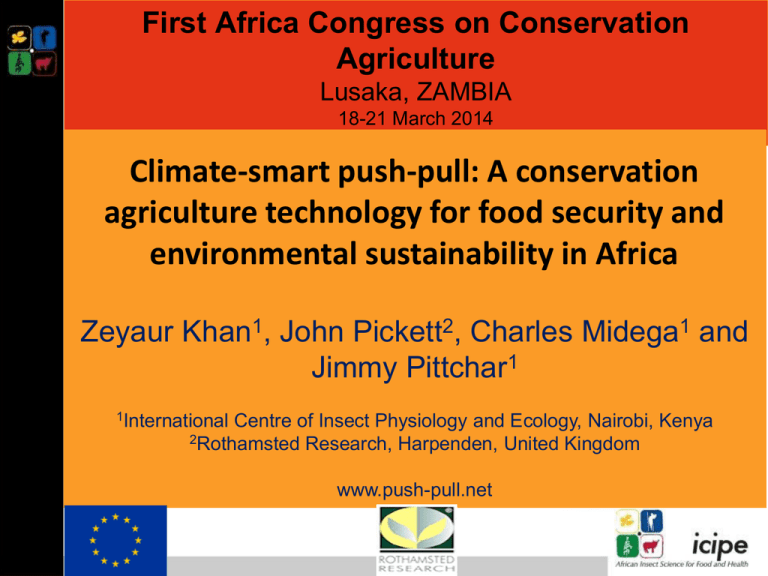
First Africa Congress on Conservation Agriculture Lusaka, ZAMBIA 18-21 March 2014 Climate-smart push-pull: A conservation agriculture technology for food security and environmental sustainability in Africa Zeyaur Khan1, John Pickett2, Charles Midega1 and Jimmy Pittchar1 1International Centre of Insect Physiology and Ecology, Nairobi, Kenya 2Rothamsted Research, Harpenden, United Kingdom www.push-pull.net HUNGER AND POVERTY IN AFRICA • Africa faces increasingly serious problems in its ability to feed its rapidly growing population, resulting in high hunger and poverty incidences. • Africa’s productivity is the lowest in the world (around 1t/ha compared with 2.4t/ha in South Asia, 3.2t/ha in Latin America and 4.5t/ha in East Asia and Pacific) • The major production constraints are pests, weeds and degraded soils. • Ecologically sustainable growth in agricultural productivity is essential to end hunger and poverty and ensure food security, by naturally reducing incidence of the major constraints to productivity Chilo partellus Busseola fusca Maize worth US$ 1.5b is lost annually due to stemborers in SSA 24% of the total maize cropping area in SSA is infested with Striga. Value of maize lost due to Striga is at least US$ 1.2 b What is ‘Push-Pull’ Strategy? The ‘Push-Pull’ strategy is a novel approach in pest management which uses a repellent intercrop and an attractive trap plant. Insect pests are repelled from the food crop and are simultaneously attracted to a trap crop. Main Crop Trap Crop Attract moths Attract natural enemies Moths are pushed away Cook, Khan and Pickett (2007) Annu. Rev. Entomol. 52 : 375-400 Push-Pull Strategy 1= (E)-ß-ocimene; 2= α-terpinolene; 3= β-caryophyllene; 4= humulene; 5= (E)-4,8-dimethyl-1,3,7nonatriene; 6= α-cedrene; 7= hexanal; 8= (E)-2-hexenal; 9= (Z)-3-hexen-1-ol; 10= (Z)-3-hexen-1-yl acetate ; 11= 5,7,2′,4′-tetrahydroxy-6-(3methylbut-2-enyl)isoflavanone (uncinanone A); 12= 4′′,5′′-dihydro-5,2′,4′trihydroxy-5′′-isopropenylfurano(2′′,3′′;7,6)-isoflavanone (uncinanone B); 13= 4′′,5′′dihydro-2′methoxy-5,4′-dihydroxy-5′′isopropenylfurano-(2′′,3′′;7,6)isoflavanone (uncinanone C), 14= di-C-glycosylflavone 6C-α-L-arabinopyranosyl-8-C-βDglucopyranosylapigenin Benefits of Push-Pull Technology Sustainable Development Gender & Social Equity Technological Empowerment of farmers Stemborers and striga control Increased fodder production Increased crop yields Improved cattle health Improved dairy production Improved FYM Production Improved human health N-fixation and reduced soil erosion Increased forage seed production Conservation of biodiversity Increased household income Improved soil health Empowerment of women NITROGEN FIXATION WITH VARIOUS INTERCROPS AFTER THREE YEARS 0.25 Total N (g) / 250 g Soil a 0.2 0.15 b b b b 0.1 0.05 0 Maize Monocrop Maize + Desmodium Maize + Soybean Maize + Sunhemp Intercrops Khan et al. 2006. Biological Approaches to Sustainable Soil Systems, CRC Press Maize + Cowpea On-Farm Validation of ‘Push-Pull’ Technology (n=420) 30 % stemborer damaged plants Maize monocrop fields Push-pull fields 25 20 15 * 10 * 500 * * 5 No. of emerged striga/63 maize plants 400 300 200 * 100 0 * * * Maize Yields (t/ha) 4 3 * * 2 * * 1 0 2003 2004 2005 2006 Khan et al. 2008. Field Crops Research 106: 224-233 Integration with livestock Integrating push-pull with livestock production Adaptation of Push-Pull to Climate Change With funding by European Union, we have adapted the push-pull technology to the increasingly dry and hot conditions associated with climate change in Africa to ensure its long term sustainability. SELECTION OF NEW DROUGHT TOLERANT COMPANION PLANTS Brachiaria cv mulato Desmodium intortum Vetiver grass Screening for drought tolerant companion plants for use in adapted push-pull for drier areas of Africa Research into New drought tolerant African Desmodium spp. D. incanum D. repandum D. ramosissimum CLIMATE-SMART PUSH-PULL A healthy sorghum crop under climate-adapted push-pull. D. intortum suppresses striga and stemborers by up to 100% and 70% respectively in sorghum, resulting in significant yield increases, from less than 1t/ha to about 3.2t/ha. CLIMATE-SMART PUSH-PULL Increased yield as striga and stemborer controlled in sorghum and millet 4000 Yield, Kg/ha 3000 2000 1000 0 Adapted Push-Pull Control Maize plot Adapted Push-Pull Control Sorghum plot First season on-farm results of maize and sorghum yields from push-pull plots planted with the drought tolerant companion plants: Brachiaria c.v.Mulato II as the trap plant and Greenleaf desmodium as the intercrop plant. Farmers’ Perceptions of ADOPT Push-pull Technology Adoption About 18,000 of the adopters planted climate-adapted push-pull by December 2013 Climate-smart push-pull addresses multiple constraints Major constraints How Push-pull addresses Constraints Low soil fertility Increased nitrogen fixation by the intercrop Degraded land Control soil erosion; increased organic matter and soil physical properties The parasitic striga weed Striga control by the intercrop, striga seed depletion Stemborer pests Effective stemborer control by companion plants, and natural enemies Moisture stress Soil moisture conservation, improved water holding capacity by intercrops Low crop yields Increased cereal yields (maize from 1 to 3.5t/ha; sorghum 0.8t to 2t/ha; millet 0.4t to 0.8t/ha) Shortage of livestock All year round quality fodder from the trap and intercrop plants fodder leading to improved milk production Loss of biodiversity Increased abundance and diversity of beneficial organisms Shortage of labour Reduced labour requirement for land preparation and weed control Developing long term sustainability and system resilience •We make the best use of locally adapted crop varieties and livestock breeds through their management; •We harness agro-ecological processes such as biological nitrogen fixation, allelopathy, predation and parasitism; •We avoid the unnecessary use of external inputs; •We minimise the use of practices that have adverse impacts on the environment and human health; •We make productive use of human capital - knowledge and capacity to adapt and innovate as well as social capital to resolve common landscape-scale problems. Sustainable Green Revolution in Africa ? A green revolution in Africa will come from adoption of simple, environmentally sustainable and low cost platform technologies like push-pull, which are developed by understanding and exploiting basic and applied sciences. These technologies will address food security and livelihood of smallholders without requiring extra resources for crop protection and soil improvement and without causing any ecological and social harm. THANK YOU Conservation methods for better livelihoods, better future…
